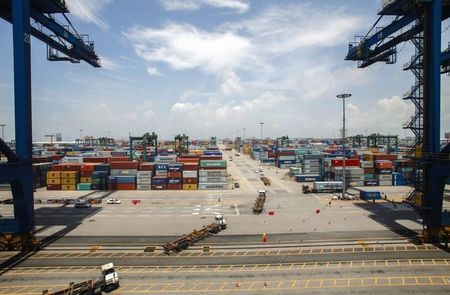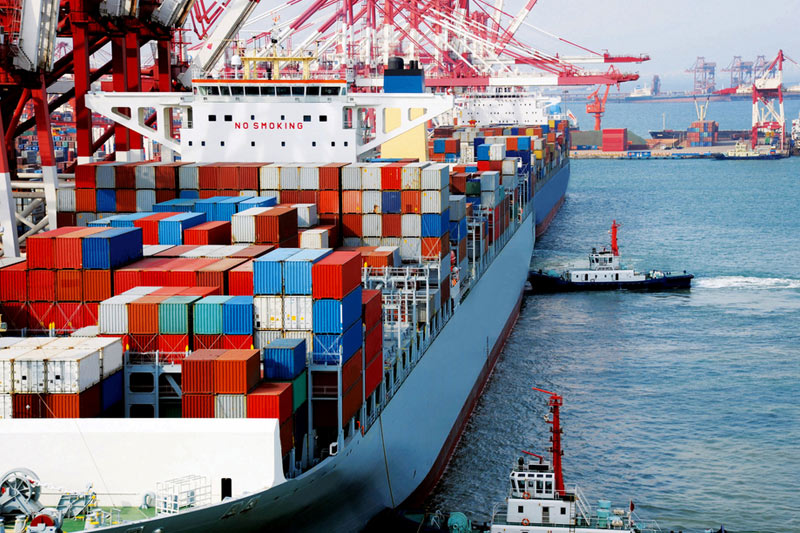By Xiaoyi Shao and Kevin Yao
BEIJING (Reuters) - China's export performance in September beat forecasts, taking some pressure off policymakers as they try to avert a sharp downturn in the world's second-largest economy, but domestic demand likely remains weak despite surprisingly firmer imports.
Economists said it was too early to tell if China's trade sector has turned the corner, adding that unexpectedly buoyant imports last month could be do to one-off factors, such as factories taking advantage of sliding global commodity prices to replenish inventories of iron ore, copper and oil.
"Today's data is less good news than it appears," said Louis Kuijs, chief China economist at Royal Bank of Scotland in Hong Kong.
"It suggests that China's export growth is holding up. However, the important caveat coming from the breakdown of the import data suggests that demand growth in China's own economy remains weak."
Exports rose 15.3 percent in September from a year earlier, beating a median forecast in a Reuters poll for a rise of 11.8 percent and quickening from August's 9.4 percent rise.
Imports rose 7 percent in terms of value, compared to a Reuters estimate for a 2.7 percent fall. Iron ore imports rebounded to the second highest this year and monthly crude oil imports rose to the second highest on record.
As a result, China posted a trade surplus of $31 billion (19.24 billion pounds) in September, down from $49.8 billion (30.90 billion pounds) in August.
Most analysts expect China's exports to stay relatively robust in the coming months as global demand, especially from the United States, strengthens.
But they say it is too early to see a pick-up in China's domestic demand as its property market continues to slow, weighing on the broader economy.
"We expect the surge in import growth to prove short-lived," Julian Evans-Pritchard, China Economist at Capital Economics, said in a research note.
The property downturn is widely seen by analysts as the biggest single threat to China's economy, and the slowdown there could well determine the shape and scope of any more stimulus measures that Beijing decides to roll out in coming months.
Facing falling house prices in a record number of cities and fears that cash-strapped property developers could be pushed into default, the government relaxed lending rules for home buyers in late September.
But it is not yet clear if that move will be enough to stabilise prices. Economists cite huge inventories of unsold homes and state media report that banks are reluctant to offer big discounts on mortgages for fear of hurting their earnings.
Buffeted by unsteady exports and the housing downturn, China's economy has had a bumpy ride this year, prompting a flurry of government stimulus measures aimed at the most vulnerable sectors.
The latest Reuters poll showed the economy likely grew at its weakest pace in more than five years in the third quarter as the property downturn weighed on demand, raising the chances of more aggressive policy steps that may include cutting interest rates.
If sustained, healthy growth in trade could temper such policy action.
NO HARD LANDING
Top policymakers have issued a steady stream of reassurances about the economy in recent days, citing among other things a strong services sector and a still resilient labour market.
Premier Li Keqiang said late last week that China will avoid a hard landing despite worries over the real-estate market. He also said he was confident the economy would continue to grow at a "medium to high tempo", forecasting growth of about 7.5 percent this year despite turbulence in the world economy.
Central Bank Governor Zhou Xiaochuan echoed that growth forecast on Monday, saying the job market is performing better than expected and adding that the central bank would continue to implement prudent monetary policy.
Third quarter GDP along with September retail sales, industrial output and investment data will be released on Oct. 21.

The data is expected to point to an economy that is still wobbling, raising questions about whether policymakers should do more to fight the slowdown.
(Reporting by Shao Xiaoyi, Judy Hua and Koh Gui Qing,; Editing by Kim Coghill)
